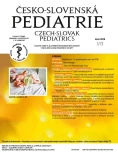Benefit of a sustained inflation manoeuvre in postnatal stabilization of extremely preterm infants born on the threshold of viability
Authors:
T. Lamberská; R. Plavka
Authors‘ workplace:
Neonatologické oddělení s JIRP, Gynekologicko-porodnická klinika VFN a 1. LF UK, Praha
Published in:
Čes-slov Pediat 2018; 73 (1): 10-15.
Category:
Overview
Background and objective:
The need for intubation in the delivery room is high and negatively dependent on gestational age in extremely preterm infants. Sustained inflation manoeuvre (SIM) is a physiological concept that can reduce the need for intubation in the delivery room and thus positively influence long-term outcome of extremely premature infants.
Method:
Retrospective analysis of prospectively collected data of premature infants stabilised after delivery in a unique research resuscitation bed, which allows two simultaneous video recordings. Data has been collected since 2010. Infants born at <30 weeks of gestation were resuscitated according to the internal guideline based on the ILCOR recommendation. In 2013, SIM with a pressure of 25 cm H2O for 15–20 seconds was implemented to the resuscitation procedure. The primary outcome was the need for intubation in the delivery room before and after the introduction of the SIM. The incidence of death before discharge and severe neonatal morbidity were also compared.
Results:
After the introduction of the SIM, the need for intubation in the delivery room was reduced. For a subgroup of infants born at <25 weeks of gestation age was a statistically significant reduction (18/25, 72% versus 8/24, 33%, p<0.007). There was a significant reduction in the need for artificial ventilation in the first 72 hours of life (9/24, 37% versus 16/25, 64%, p=0.064) and severe intraventricular hemorrhage (3/24, 12% vs. 9/25, 36%, p=0.055). In contrast, the incidence of patent ductus arteriosus significantly increased (10/24, 41% vs. 4/25, 16%, p<0.05).
Conclusion:
The introduction of SIM to the clinical practice has reduced the need for intubation in the delivery room, especially in extremely preterm infants born on the threshold of the viability, which could have a positive effect on reducing the incidence of cranial morbidity. Promising results should be confirmed in randomised trials focusing on this unique, fragile population.
Key words:
sustained inflation manoeuvre, delivery room stabilisation, extremely preterm infants
Sources
1. Hooper SB, Te Pas AB, Lang J, et al. Cardiovascular transition at birth: a physiological sequence. Pediatr Res 2015 May; 77 (5): 608–614.
2. te Pas AB, Davis PG, Hooper SB, et al. From liquid to air: breathing after birth. J Pediatr 2008 May; 152 (5): 607–611.
3. Wyllie J, Perlman JM, Kattwinkel J, et al; Neonatal Resuscitation Chapter Collaborators. Part 7: Neonatal resuscitation: 2015 International Consensus on Cardiopulmonary Resuscitation and Emergency Cardiovascular Care Science with Treatment Recommendations. Resuscitation 2015 Oct; 95: e169–201.
4. Wyckoff MH, Aziz K, Escobedo MB, et al. Part 13: Neonatal Resuscitation: 2015 American Heart Association Guidelines Update for Cardiopulmonary Resuscitation and Emergency Cardiovascular Care. Circulation 2015 Nov 3; 132 (18 Suppl 2): S543–S560.
5. Sweet DG, Carnielli V, Greisen G, et al. European Consensus Guidelines on the Management of Respiratory Distress Syndrome – 2016 Update. Neonatology 2017; 111 (2): 107–125.
6. Lamberska T, Luksova M, Plavka R, et al. Premature infants born at <25 weeks of gestation may be compromised by currently recommended resuscitation techniques. Acta Paediatr 2016 Apr; 105 (4): e142–e150.
7. Wallenstein MB, Birnie KL, Arain YH, et al. Failed endotracheal intubation and adverse outcomes among extremely low birth weight infants. J Perinatol 2016 Feb; 36 (2): 112–115.
8. te Pas AB, Siew M, Wallace MJ, et al. Effect of sustained inflation length on establishing functional residual capacity at birth in ventilated premature rabbits. Pediatr Res 2009 Sep; 66 (3): 295–300.
9. te Pas AB, Siew M, Wallace MJ, et al. Establishing functional residual capacity at birth: the effect of sustained inflation and positive end-expiratory pressure in a preterm rabbit model. Pediatr Res 2009 May; 65 (5): 537–541.
10. Sobotka KS, Hooper SB, Allison BJ, et al. An initial sustained inflation improves the respiratory and cardiovascular transition at birth in preterm lambs. Pediatr Res 2011 Jul; 70 (1): 56–60.
11. Tomori Z, Benacka R, Donic V. Mechanisms and clinicophysiological implications of the sniff- and gasp-like aspiration reflex. Respir Physiol 1998 Oct; 114 (1): 83–98.
12. Schmölzer GM, Kumar M, Aziz K, et al. Sustained inflation versus positive pressure ventilation at birth: a systematic review and meta-analysis. Arch Dis Child Fetal Neonatal Ed 2015 Jul; 100 (4): F361–F368.
13. Lista G, La Verde PA, Castoldi F. Sustained inflation and its role in the delivery room management of preterm infants. Neonatology 2016; 109 (4): 366–368.
14. te Pas AB, Kitchen MJ, Lee K, et al. Optimizing lung aeration at birth using a sustained inflation and positive pressure ventilation in preterm rabbits. Pediatr Res 2016 Jul; 80 (1): 85–91.
15. Perlman JM, Wyllie J, Kattwinkel J, et al. Neonatal Resuscitation Chapter Collaborators. Part 11: Neonatal resuscitation: 2010 International Consensus on Cardiopulmonary Resuscitation and Emergency Cardiovascular Care Science With Treatment Recommendations. Circulation 2010 Oct 19; 122 (16 Suppl 2): S516–S538.
16. Ltd SG. Digital video recorders of Tral 3 – Product information. Available from URL http://www.smp-group.com/product- tral3.html2006-9 (accessed on September 23, 2013).
17. van Vonderen JJ, Hooper SB, Hummler HD, et al. Effects of a sustained inflation in preterm infants at birth. J Pediatr 2014 Nov; 165 (5): 903–908.
18. Lista G, Cavigioli F, La Verde PA, et al. Effects of breathing and apnoea during sustained inflations in resuscitation of preterm infants. Neonatology 2017; 111 (4): 360–366.
19. Crawshaw JR, Kitchen MJ, Binder-Heschl C, et al. Laryngeal closure impedes non-invasive ventilation at birth. Arch Dis Child Fetal Neonatal Ed 2017 Oct 20. pii: fetalneonatal-2017-312681.
Labels
Neonatology Paediatrics General practitioner for children and adolescentsArticle was published in
Czech-Slovak Pediatrics

2018 Issue 1
Most read in this issue
- What disease can be hidden behind a diagnosis of erythema nodosum
- Neonatal pneumothorax – incidence and risk factors
- Neonatal outcomes of extremely preterm newborns in Czech Neonatal Network
- Measles in childhood – experience from the outbreak in Ostrava region in 2017
